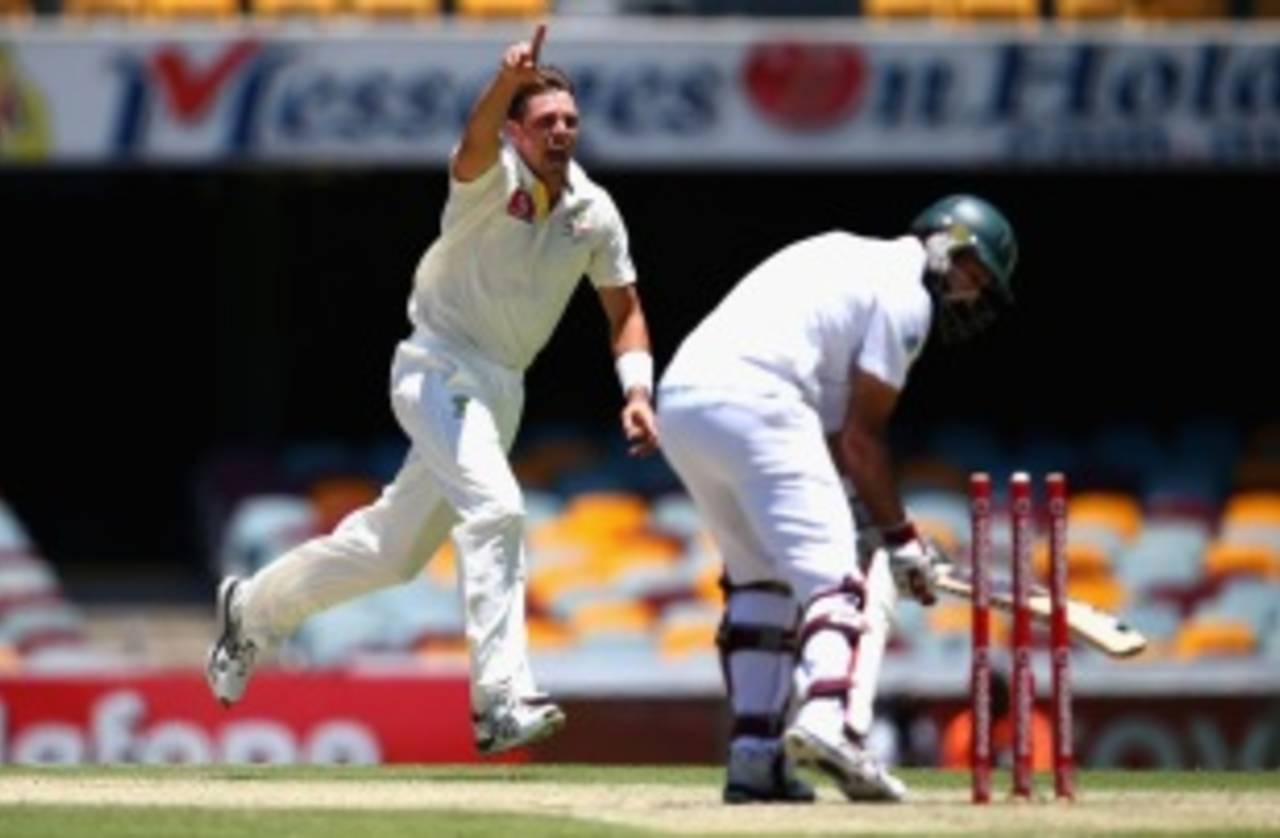On the first morning of
this Test, Australia's bowlers were out in the middle of the Gabba with a measuring tape and a can of spray paint. It has become a ritual of the modern-day bowler, calculating to the centimetre the distance they require from the crease to the top of their run-up, and marking the spot with a graffito of their initials and a line. It is a precise operation. It is also becoming a futile one.
When
James Pattinson steamed in on the final day and bowled Hashim Amla, the Australians were jubilant. Briefly. The umpire, Asad Rauf, told Amla not to walk off the ground just yet. He suspected Pattinson had over-stepped the crease and asked the third official to check the replays. Rauf's instinct was right. Pattinson had delivered a no-ball and Amla was reprieved. It was the third such incident in this match.
On the first day, Peter Siddle had Jacques Kallis caught at mid-off. Again it was Rauf who wanted the replay checked, and again the bowler had over-stepped. And on day three
Morne Morkel, a serial no-baller, thought he had Ed Cowan caught behind and the South Africans asked for a review of Rauf's not-out decision. The first footage to be viewed by Richard Kettleborough was the side-on angle, and he deemed that Morkel had not bowled a legal delivery.
Three dismissals disallowed by no-balls, in addition to another that was called on the spot, which Michael Clarke appeared to edge behind off Morkel. When run-ups are measured so precisely, how can that be? Geoff Lawson, the former fast bowler and coach, argues that the run-up length can only ever be a rough guide because when a bowler is running in, the length of his steps will vary based on a number of factors. Is there a head-wind or a tail-wind? Is the outfield soft or hard? Is he running marginally uphill or downhill? And when he bowled Amla, Pattinson was in such a fired-up mood that he might have been running in faster than usual, lengthening his strides.
Reprieving a batsman on a late no-ball call is vastly preferable to wrongly calling one and having a batsman dismissed. The bowling team would feel aggrieved, and rightly so. But nor would it be fair to give the batsman out retrospectively
Still, some bowlers find a way around no-balls. It is often claimed that Michael Holding sent down only two in his Test career.
Ben Hilfenhaus bowled one in the first Test in the West Indies in April, but hasn't been called in the three Tests since then. Is their secret to measure a run-up and then start from yet another step back? Who knows. But it was notable that when the Australians asked for a review of a Hilfenhaus caught-behind appeal, his front foot was so far back in legal territory that his toes weren't even touching the crease.
Others, like Morkel, get it wrong on a frustratingly regular basis. When Morkel made his first-class debut at the age of 19, he sent down 17 no-balls in a five-over spell. The habit has stayed with him. On the last day of the
Lord's Test in August, Morkel had Matt Prior caught in the deep off a no-ball. Siddle also has prior form. At the MCG last year, he bowled Rahul Dravid and the umpire, Marais Erasmus, asked for the no-ball to be checked. Siddle had overstepped.
It could be argued that the standing umpires should be more inclined to call bowlers on the spot, rather than waiting for a wicket to fall. Who knows how many no-balls are missed during regular play because the umpire hasn't felt sure? Certainly in Pattinson's case, Rauf could have made the call himself, for Pattinson was over the crease by a considerable distance. But the Siddle and Morkel margins were minimal.
The umpires still called 33 no-balls for the match and had assistance for less than a handful of those. If in doubt, umpires must err on the side of caution. Reprieving a batsman on a late no-ball call is vastly preferable to wrongly calling one and having a batsman dismissed. The bowling team would feel aggrieved, and rightly so. But nor would it be fair to give the batsman out retrospectively.
Who can say if a batsman would have played the same shot had he not heard the umpire call no-ball? Against a genuinely fast bowler, batsmen don't have time to adjust to hearing an umpire's call, but they do against spinners. And what of medium-pacers? Or a fast man's slower ball?
There must be one blanket rule and the current system is the best option. It is certainly preferable to a batsman being sent on his way, only for TV viewers to later see he was dismissed off a no-ball. Whether the review process adds to or detracts from the spectacle of the game is a matter of opinion. Whether bowlers are overstepping, generally, is not. Perhaps some should look to Holding and Hilfenhaus for inspiration.
